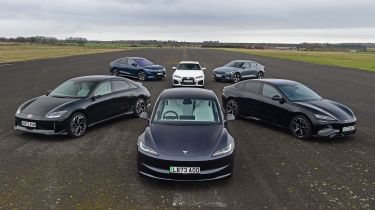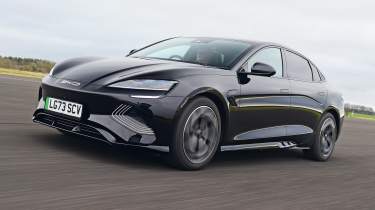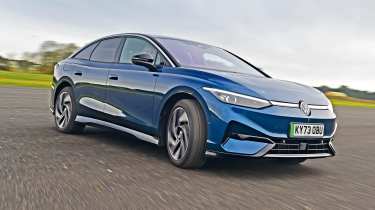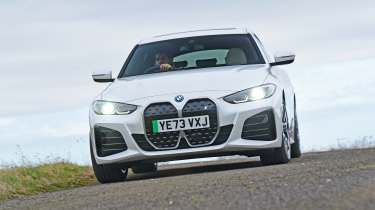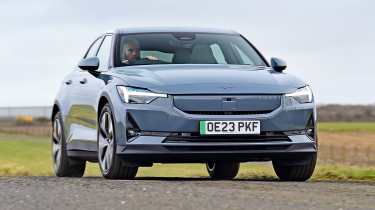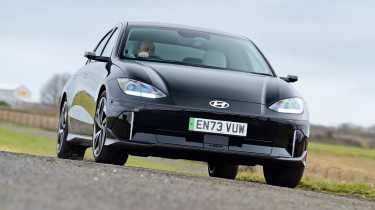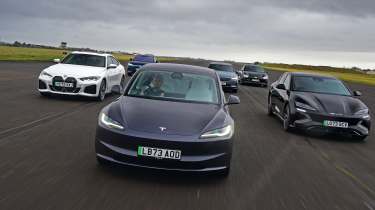Tesla Model 3 vs its five biggest rivals
Drivers are spoiled for choice in the flourishing EV company car market, but which of our six rivals does the business?
The company car landscape has been transformed beyond all recognition in the past 20 years or so, and a big part of that is down to the flourishing electric car market. If you want a three-box saloon, it’s no longer Ford or Vauxhall that fleet managers turn to, but Tesla and BMW.
Cars such as the Model 3 and i4 are also among the best EVs on the market, and prime candidates for company car users. The last time these two rivals went head to head, the BMW had the edge, but Tesla has since launched a heavily updated Model 3, so will that be enough to turn things in its favour?
Not that Tesla and BMW have the electric saloon car market sewn up, because a wave of new arrivals has recently hit showrooms, most notably Chinese brand BYD. The company has quickly introduced a range of capable and competitively priced models, and its Seal has the i4 and Model 3 in its sights. Elsewhere, Volkswagen has also launched its own challenger in the shape of the ID.7, which looks to be the most convincing electric model the firm has produced yet. Up against these newcomers is another car that’s been updated recently, the Polestar 2, while the striking and gadget-laden Hyundai Ioniq 6 offers space-age styling and strong performance.
Used - available now

2021 Kia
Sportage
44,151 milesManualDiesel1.6L
Cash £14,697
2024 Cupra
Formentor
79,227 milesAutomaticPetrol1.4L
Cash £17,000
2020 BMW
5 Series Touring
44,522 milesAutomaticPetrol2.0L
Cash £19,700
2024 Cupra
Formentor
30,325 milesAutomaticPetrol1.5L
Cash £22,600So which car will come out on top in this six-way clash? When it comes to the best choice for a company car buyer, each of these EVs incurs tiny Benefit-in-Kind deductions, thanks to their lowly two-per cent rating. We’ve included business contract plan prices here, but also PCP costs for private buyers, too.
| BYD Seal Excellence AWD | Volkswagen ID.7 Pro Match | Tesla Model 3 Long Range | BMW i4 eDrive35 M Sport | Polestar 2 Long Range Single Motor | Hyundai Ioniq 6 Ultimate L. Range AWD | |
| Price: | £48,695 | £51,550 | £49,990 | £52,255 | £48,950 | £54,040 |
| Powertrain: | 2x e-motors, 523bhp/494Nm, 82.5kWh batt. | 1x e-motor, 282bhp/545Nm, 77kWh batt. | 2x e-motors, 491bhp/494Nm, 75kWh batt. | 1x e-motor, 282bhp/400Nm, 70.2kWh batt. | 1x e-motor, 295bhp/490Nm, 82kWh batt. | 2x e-motors, 321bhp/605Nm, 77.4kWh batt. |
| 0-62mph: | 3.8 seconds | 6.5 seconds | 4.2 seconds | 6.0 seconds | 5.9 seconds | 5.1 seconds |
| Test efficiency: | 3.0mi/kWh | 3.4mi/kWh | 3.8mi/kWh | 3.6mi/kWh | 3.3mi/kWh | 3.1mi/kWh |
| Official range: | 323 miles | 383 miles | 390 miles | 284 miles | 365 miles | 322 miles |
| Annual BiK: | £195 | £206 | £204 | £209 | £196 | £216 |
BYD Seal
As well as being a newcomer to the class, BYD is still a very new car manufacturer to the UK, having only started selling vehicles here around 12 months ago. However, the Chinese giant has been present on these shores for longer than you might realise. Its batteries power many smartphones, plus there are 1,000-plus BYD electric buses that carry passengers throughout the nation each day. The company has the potential to be a disruptive force in the new-car market.
The first BYD sold in the UK, the Atto 3 compact SUV, proved to be a strong contender, first overcoming the Kia Niro EV and then the Peugeot E-2008 in two separate Auto Express Real-World Road Tests. The sleek-looking Seal has its targets set higher, though, wading into a market in which several premium brands try their hand.
On paper, the Seal appears more than capable of taking on the competition. The top-spec Excellence tested here is the most powerful car in this line-up; its twin-motor set-up offers up a super-saloon-like 523bhp. That’s 20bbhp more than the BMW M3 Competition. It also comes as no surprise that, because BYD is first and foremost a battery manufacturer, the Seal leads the way for overall capacity, with an 82.5kWh pack slotted between the axles.
With all that power, rapid acceleration is a given, with the 0-62mph benchmark dispatched in 3.8 seconds – a number that this model even proudly displays on the bootlid. However, in the cool conditions of our test, the Seal rarely felt close to matching that performance. It was by no means slow, but it didn’t stand out against the competition.
The Seal wasn’t helped by a throttle that was the least responsive of all six cars. It gives the model a character that’s reminiscent of an old-school turbocharged car, with a modest initial push followed by a great surge moments later. With so much performance potential, we would have liked to apply the power a little more progressively. The same goes for the brakes, which don’t have the finest feel and have a distinct step between energy recovery and mechanical friction.
The Excellence model tested here is fitted with adaptive dampers, which undoubtedly add a level of sophistication over the passive set-up offered elsewhere in the range. The system helps to disguise the mass of the car, and while the Seal still thumps into some larger potholes, it’s reasonably comfortable on the whole. There is fairly pronounced body roll through the corners when pushing on, but although the balance is reasonable, any attempt at enthusiastic driving is curtailed by the most intrusive electronic stability control among this group of six.
Inside, the wraparound dashboard feels more sporty than some of the alternatives here. If you enjoy listening to music then the Seal is the car to have; the sound system is by Danish hi-fi brand Dynaudio, and its quality and power are absolutely superb.
There are other areas that are less impressive, though. An official maximum charging rate of 150kW is the slowest among this sextet, but when using rapid chargepoints from various providers, we didn’t even achieve half of that speed, even with just 10 per cent of energy remaining in the battery. At 3.0mi/kWh, the Seal was the least efficient car on test, too, and it’s also pricey on a three-year PCP deal; place a £5,000 deposit with a 10,000-mile annual limit, and it’ll cost £804 per month. That makes the BYD the second most expensive car here.
Volkswagen ID.7
Volkswagen’s first ground-up EV based on its MEB architecture, the ID.3, launched with a huge amount of fanfare, but didn’t quite hit the mark. However, the potential of the platform has since been unlocked with a mid-life update for the electric hatch, plus the introduction of the fabulously charming ID.Buzz MPV.
The ID.7 is to the Passat what the ID.3 is to the Golf, which means the model slots into this electric company car contest perfectly. It seems as if Volkswagen’s constant refinements of the MEB platform have taken another step here, because in many ways the ID.7 is the most convincing electric vehicle the brand has yet produced.
None of its stats look remarkable at first glance; its 77kWh battery is the fourth largest here, the single 282bhp rear-mounted motor matches the BMW’s as the least powerful of this six, and 175kW charging, enough for a 28-minute top-up from 10-80 per cent, is fourth best. However, one outstanding figure is the ID.7’s size, because at 4,961mm, it’s comfortably the longest car here, plus it’s also the tallest. That can be really felt in the rear of the car, where it’s simply vast.
Kneeroom is limo-like, headroom is the best of this group, and the large windows mean there’s a great view out. The 532-litre boot is both the largest and most usable here, thanks to the large hatchback opening – even if the bumper is quite deep – and levers in the load bay drop the rear seats almost flat to create a volume that totals 1,586 litres. There’s
a huge parcel shelf to conceal the large gap between the rear seats and window line, but there’s also enough room to house it beneath the boot floor when you need to fill the cargo area to its maximum capacity.
The rest of the cabin looks smart, is well built and has excellent storage. The touchscreen system works better than in other ID models – including illuminated slide controls beneath the screen – but it has introduced its own ergonomic frustrations. For example, manual air-vent control is gone, replaced by a sub-menu within the infotainment system, which feels like an unnecessary extra level of complexity.
Fortunately, the way the ID.7 drives makes up for this. All of these cars weigh somewhere in the region of two tonnes, so none of them is going to be the most exciting vehicle to drive, but Volkswagen has leaned fully into this realisation by focusing on comfort. Our car was fitted with adaptive dampers, whose rates can be adjusted on a sliding scale, but even in their firmest setting, the ID.7 was the most compliant model over bumps in our test. In its softest mode, it’s positively serene, floating over uneven surfaces that its rivals fidget over and thump into. It’s also incredibly quiet at a cruise.
The trade-off for this is, of course, handling. But while the ID.7 feels a little heavy to respond to direction changes and rolls the most through the turns, it’s still neatly balanced and grippy enough. Officially the German EV will crack the 0-62mph sprint in 6.5 seconds, which is more than adequate for a car such as this, and a keen throttle response makes it feel lively. We’d like more brake-regeneration options, though, and the pedal itself feels soft under foot.
During our test, the ID.7 averaged 3.4 miles/kWh, which was the third best result here. The Volkswagen also ranks third best for its PCP figures; thanks to a £2,000 deposit contribution and VW’s low 3.9-per cent APR finance rate, this Pro Match trim costs £683 per month.
Tesla Model 3
Surrounded by the usual hype of a Tesla launch, the Model 3 first hit North America in 2017 and reached the UK two years later. Now the brand’s smallest model – and the one that’s arguably best suited to British roads – has received its first significant update.
On the outside, a subtle styling revamp inspired by the company’s Roadster sports car has made an already slippery body even more aerodynamically efficient, while the cabin gets a cleaner look that has even fewer physical controls than before. The 15.4-inch screen operates nearly everything; even selecting drive or reverse now requires a swipe up or down on the edge of the display. Tesla has also eliminated the car’s column stalks – the indicators and windscreen wipers are now controlled by buttons on the front of the steering wheel.
There are new front seats that are wonderfully soft, but the artificial- leather upholstery feels a little cheap. The low scuttle gives an excellent view of the road ahead, though, while passengers in the back now get a screen of their own to adjust heating controls. It’s also sufficiently large that it can also be used to stream YouTube videos.
One area where the more established car brands are still yet to beat Tesla is in terms of powertrains. The dual-motor Long Range model delivers just shy of 500bhp, and yet it’s combined with a 75kWh battery that delivers an official range of 390 miles. In the real world the Model 3 proved to be the most capable of nearing its claimed WLTP figures. Our test took place in cold conditions, which tend to be unflattering for electric cars, and yet the Tesla still achieved 3.8 miles per kilowatt-hour, enough for a real-world range of 285 miles. In summer, that number will easily breach 300 miles.
The Model 3 also has the most precise throttle control, enabling drivers to move at low speeds with a chauffeur-like smoothness, although some of our testers wished there was a way to adjust the level of brake regeneration; there’s only one setting and it’s very strong.
Tesla says that refinement has been a key focus of the new Model 3, with wind noise reduced by 30 per cent over the old car, thanks to insulated glass, revised suspension bushings, improved door seals and sound-deadening materials. The Tesla wasn’t quite the quietest at a motorway cruise, but a bassy rumble from the tyres aside, it was among the more hushed of our six contenders on this test.
Performance is fantastic, and the Model 3 felt like the quickest car of this group in a straight line; Tesla’s claimed 0-62mph time of 4.2 seconds is entirely believable. Combined with strong grip, the American model shows great cross country pace, but due to a slight baggy feeling from the suspension, a brake pedal that’s short on feedback, and hyperactive steering that is more akin to a cheap arcade racing game than an actual car, it’s hard to call the Model 3 fun.
The tied-down feeling through the turns hasn’t come at the expense of comfort, because the Model 3 still rides reasonably well. There’s a little bit of patter at low speeds on the standard 18-inch wheels, but it still beats the Hyundai, Polestar and BYD for comfort.
Tesla’s Supercharger network is still by far the best public charging option we’ve come across; simply turn up, plug in and leave when you have enough charge – your usage is paid for via direct debit each month. At 250kW, a 10-80 per cent top up takes just 27 minutes.
If you’re financing privately rather than through a fleet deal, Tesla’s choice to not offer any PCP incentives hits the Model 3 hard. Place a £5,000 deposit on a three-year PCP with a 10,000-mile annual limit, and the Model 3 Long Range is £853 per month, making it the most expensive car in this contest by some margin.
BMW i4
While the BMW i4 isn’t an all-new car, we’re testing it here with a new addition to the powertrain options. The eDrive35 is now the entry point to the range, undercutting the existing eDrive40 by almost £8,000. The compromise for that lower price is that power drops from 321bhp to 282bhp, torque is 30Nm lower, at 400Nm, and the battery capacity now stands at 67kWh, down from 77.4kWh.
At £52,255, this M Sport trim is still one of the more expensive cars in this test to buy outright, but thanks to a mix of a £1,561 deposit contribution from BMW and the strongest residuals of any car in this group (it’s predicted to retain 54.5 per cent of its original value after three years), the eDrive35 M Sport’s three-year PCP cost of £760 per month undercuts the BYD by £44 a month, and the Tesla by a significant £93 per month. To keep those costs down, you do have to show a little restraint when it comes to ticking the options boxes, but the same caveat applies to both the Polestar and Tesla, too.
That still makes the BMW more expensive than the Volkswagen, but it doesn’t take long for the i4 to convince you that it’s worth the extra outlay. Settle in behind the wheel and the BMW’s cabin quality is a level beyond anything else in this line-up. Since the i4’s last appearance in an Auto Express group test just under a year ago, the previous stubby gear selector has been replaced by a smaller toggle switch, but otherwise you get the same impeccably finished cabin, which strikes the right balance between physical and touchscreen controls.
We’d still like to see some physical buttons for the climate-control system, but the on-screen keys are among the best of their type. Other infotainment functions can still be adjusted via the iDrive click wheel; the mix of input options, fast loading times and sharp graphics makes this the best infotainment system overall.
The rear seats are comfortable, with plenty of bolstering for the two outer seats to help passengers settle into them, but while headroom is fine, kneeroom is the tightest of this group. A 470-litre boot is the second largest here, though, and the BMW’s hatchback opening makes it more practical than every other car here apart from the VW.
When it comes to the driving experience, the BMW is in a class of its own compared with its rivals here. Its ride and handling balance is by far the best; the ID.7 is smoother over bumps, but the i4 isn’t uncomfortable, and it’s significantly sharper to drive. Indeed, it hardly feels any less agile than the petrol-powered 4 Series Gran Coupe that uses the same CLAR-derived platform. The i4’s steering isn’t loaded with feedback, but it’s precise and its speed is well matched to the response of the chassis, while the car’s balance is adjustable both on and off the throttle, yet it’s also predictable.
A 0-62mph time of six seconds seems unremarkable in this company, but the i4 rarely feels as if it needs more power. The car’s throttle response is also excellent, so you can access that full 282bhp whenever you need it.
Not only does that make the i4 the most fun to drive, but it’s also the quietest of this sextet at a cruise and is brilliantly stable on the motorway. Combined with an overall efficiency rating of 3.6mi/kWh – which was only bettered by the Tesla during our test– and the BMW EV is as adept at longer runs as it is on twistier roads.
Polestar 2
A mid-life refresh for the Polestar 2 was applied last year, and it introduced updated motors, battery packs and control systems to improve performance, range and efficiency. The Single Motor Long Range model moved its electric motor from the front axle to the rear, while the new configuration’s 295bhp and 490Nm are a significant 67bhp and 160Nm improvement on the original model’s. At 82kWh, the Polestar 2 has one of the largest batteries in this group, which translates to an official range of 365 miles – it’s bettered only by the Tesla and Volkswagen – while the 105kWh charging rate allows for a 10-80 per cent battery top-up in 28 minutes.
Against a group of low-slung, often slippery-looking competition, the Polestar’s upright stance and chunky design are a breath of fresh air. However, such styling does have its drawbacks; with a drag coefficient of 0.278Cd, the Swede is the least streamlined car here.
Still, with a return of 3.3mi/kWh, the Polestar wasn’t the worst-performing car for efficiency, placing fourth overall and almost matching the ID.7. The estimated range also proved to be very accurate in practice, which means we would feel confident in making the most of the car’s battery before charging, which in our test worked out to be 271 miles – a number that only the Model 3 could beat.
On the road, the Polestar 2 isn’t bad in isolation, but its rivals here highlight areas where it could be better. At low speeds the body skips from bump to bump rather than flowing across them, and that fidgety feeling continues at higher speeds. The impression of firmness suggests that it’ll be agile through the turns, but while the rear-driven chassis is sweetly balanced, body roll is more pronounced than in the BMW. That’s not the end of the story, either; the Polestar pitches and dives more under hard acceleration and heavy braking. The steering isn’t particularly responsive, but it’s precise enough, while at a motorway cruise the Polestar proved to be the least refined, with the most pronounced road and wind noise of the group.
The brakes are a definite area for Polestar to focus on in future updates. There are only two modes of regenerative braking, and they can be accessed solely through the touchscreen. The pedal itself is very firm at the top of its travel, while there isn’t much more power as you press harder. It’s certainly less reassuring than the response from the BMW’s brake pedal. The accelerator is much sweeter, though, with the pedal offering a smooth, natural action that will be familiar to anyone who has driven a petrol-powered car.
From the driver’s seat the Polestar 2 feels very sporty. The narrow, high centre console, mixed with the wraparound dash, makes you feel like you’re sitting in a low-slung sports car rather than a mildly jacked-up four-door. Rearward visibility is a little compromised by a small window, though. The light-coloured leather on the doors and the seats, mixed with darker plastics and grey fabrics, give the Polestar 2 an understated feel, which is modern while not being too wacky. The door handles, column stalks and vent controls all feel suitably chunky, although storage is at a bit more of a premium here than in its rivals.
The Polestar is one of three cars here with a proper hatchback opening, so even though its 448-litre boot volume isn’t very special on paper, it’s one of the more practical options in this class.
Hyundai Ioniq 6
Hyundai’s design team has been on a roll of late, with mainstream models such as the Tucson and Kona SUVs delivering dramatic and unique looks. The Korean brand has really pushed ahead with the look of its EVs, too. Whether it’s the wonderfully chunky, retro appearance of the Ioniq 5, or the streamlined shape of the Ioniq 6 we have here, few other cars at their respective price points stand out as much. The Ioniq 6’s shape isn’t just for show, either, because an official drag coefficient of 0.21Cd makes it the slipperiest car in this contest.
It’s not short of punch, either. The top-spec Long Range AWD model has a dual-motor set-up that pumps out 321bhp and 605Nm of torque, making it one of the most potent cars in this group. There is a less powerful option, a single-motor model that sends 225bhp to the rear wheels and costs £4,200 less, but both versions feature the same 77kWh battery, which can be replenished by 220kW charging – one of the fastest rates here. That means a 10-80 per cent charge can take as little as 18 minutes – significant when you’re making longer trips.
The Ioniq 6’s interior design demonstrates that Hyundai has come a long way in a very short space of time. Material quality isn’t quite up to the standards of Polestar or BMW, but the level of finish is hard to fault. Unlike any other car here, the Ioniq has a full bank of physical controls for the ventilation, plus further buttons that are shortcuts for the infotainment menu. That’s a good thing, not only because it makes it easy to work out when you’re on the move, but also because the Hyundai’s touchscreen system has some convoluted menus – especially around the driver-assistance functions. As with the Tesla, the dashboard is set fairly low, which provides a great view ahead, but over-the-shoulder visibility isn’t as impressive.
The Ioniq 6 isn’t short on tech, and it includes vehicle-to-load capability. This means it has a three-pin plug socket at the base of the rear-seat bench, which allows you to use the drive battery to power electrical appliances such as camping equipment, as opposed to simply charging smaller devices via the USB sockets.
Rear legroom is the best of any car here, with an absolutely huge space between the front and rear seats. It needs this, however, because headroom is the tightest of the bunch. Despite the car’s relatively long dimensions, the Hyundai’s 401-litre boot volume is a little underwhelming and the shape is long and shallow. Its saloon-like opening is slightly larger than the Model 3’s, though, and levers in the boot drop the back seats so that longer items can be accommodated.
On the road, the Ioniq 6 doesn’t stand out in any particular area when compared with its rivals here. The ride is as firm as the Polestar’s, but it’s slightly more crashy, the car is a little nose-heavy during quick direction changes, and there’s a slight delay in throttle response, which takes the edge off its otherwise strong performance.
When it comes to stopping, the brakes are among the best here. They’re powerful and controlled by a well weighted pedal, while paddles on the steering column allow you to adjust that strength of energy recovery, ranging from full coasting to one-pedal driving. We wish every EV had a similar arrangement. All of this can also be found on the single-motor model, however, and we’d lean towards that car and take advantage of its lower asking price.
Results
Which car comes out on top?
Winner: Tesla Model 3
Company car choice is a numbers game, and on this basis, the revised Model 3 is the best in the class. Nothing comes close to its performance, efficiency or charging convenience, all of which should make it great to live with and cheap to run. Comfort, refinement and build quality have all been improved, and while it isn’t the most fun to drive, it’s competent. A few more physical buttons wouldn’t go amiss though.
Runner-up: BMW i4
For some, a car is about more than just numbers, and it’s the subjective qualities that you can appreciate every time you take to the road. If that sounds like you, then you’ll be much happier behind the wheel of the i4 than the Tesla. It’s by far the best car to drive; not only is it the sharpest handling by some margin, but it’s also the most refined and second only to the VW for ride comfort. It’s also one of the most efficient, and has the smartest interior and the best balance between touchscreen and physical controls.
Third place: Volkswagen ID.7
The ID.7 really feels like a return to form for Volkswagen. It’s the most accomplished all-electric model the brand has yet produced, and it goes straight to the top of the class for comfort and practicality, while its above-average efficiency and performance also appeal. There are one or two ergonomic foibles common to the ID range that still baffle us, but they’re not enough to detract from the ID.7’s strengths elsewhere.
Fourth place: Polestar 2
Fourth place could be seen as a disappointment for the Polestar 2, but the car is still a very appealing proposition. It’s great to look at and performs well, while the interior is a pleasant place to be. Polestar’s zero-per cent finance offer makes it great value if you’re looking to buy privately, too. The brand needs to decide whether it wants the 2 to be a comfortable cruiser or a keen driver’s car, though, because at the moment it’s neither.
Fifth place: Hyundai Ioniq 6
Nothing else on the road looks like the Ioniq 6, and that will be more than enough to attract some company-car users. It’s loaded with equipment, too, and we love Hyundai’s solution for adjusting the brake regeneration, but the Ioniq 6 doesn’t quite have the polished driving experience it needs to compete with the best cars here. Tight headroom, a shallow and compact boot, and underwhelming efficiency peg the car back to fifth place.
Sixth place: BYD Seal
Currently the Seal just falls short of matching the level of the Polestar and Hyundai. There are a few areas in which BYD needs to add some refinements in order to compete at this level. We’re fans of the standard kit, seat comfort and sound system, though. For a manufacturer’s first attempt in this class, the Seal is impressive, and with some improved calibration, efficiency and chassis sophistication, it could be a real contender.
Which would you buy? Let us know in the comments section below…
Specs and prices
| BYD Seal Excellence AWD | Volkswagen ID.7 Pro Match | Tesla Model 3 Long Range | BMW i4 eDrive35 M Sport | Polestar 2 Long Range Single Motor | Hyundai Ioniq 6 Ultimate Long Range AWD | |
| Price/total as tested | £48,695/£48,695 | £51,550/£57,180 | £49,990/£53,090 | £52,255/£60,700 | £48,950/£55,850 | £54,040/£55,735 |
| Monthly cost | £804 x 36 months | £683 x 36 months | £853 x 36 months | £760 x 36 months | £651 x 36 months | £621 x 36 months |
| Manufacturer deposit contribution | £0 | £2,000 | £200 | £1,561 | £0 | £0 |
| Optional final payment | £21,533 | £24,599 | £23,495 | £26,082 | £20,520 | £26,670 |
| Representative APR | 6.90% | 3.90% | 9.00% | 5.90% | 0% | 0% |
| Excess mileage charge | 14.9p per mile | 9.9p per mile | 14p per mile | 15.8p per mile | 14.9p per mile | 9p per mile |
| Other fees | £0 | £10 | £0 | £10 | £150 | £0 |
| Monthly cost | £560 | £450 | £698 | £432 | £424 | £415 |
| Powertrain | 2x e-motors/lithium-ion battery | 1x e-motor/lithium-ion battery | 2x e-motors/lithium-ion battery | 1x e-motor/lithium-ion battery | 1x e-motor/lithium-ion battery | 2x e-motors/lithium-ion battery |
| Power/torque | 523bhp/494Nm | 282bhp/545Nm | 491bhp/494Nm | 282bhp/400Nm | 295bhp/490Nm | 321bhp/605Nm |
| Transmission | Single-speed auto/4WD | Single-speed auto/rwd | Single-speed auto/4WD | Single-speed auto/rwd | Single-speed auto/rwd | Single-speed auto/4WD |
| Battery capacity/usable | 82.5/82.5kWh | 77/77kWh | 79/79kWh | 70.2/67kWh | 82/82kWh | 77.4/77.4kWh |
| Length/wheelbase | 4,800/2,920mm | 4,961/2,971mm | 4,720/2,875mm | 4,783/2,856mm | 4,606/2,735mm | 4,855/2,950mm |
| Height/width | 1,460/1,875mm | 1,536/1,862mm | 1,440/1,850mm | 1,448/1,852mm | 1,479/1,859mm | 1,495/1,880mm |
| Boot capacity front/seats up/down | 53/400 litres/N/A | 0/532/1,586 litres | 88/425 litres/N/A | 0/470/1,290 litres | 35/448/1,097 litres | 14.5/401 litres/N/A |
| Kerbweight/payload/towing weight | 2,185/446/1,500kg | 2,172/458/1,000kg | 1,828/321/1,000kg | 2,065/555/750kg | 2,009/591/1,500kg | 2,096/424/1,500kg |
| Turning circle/drag coefficient | 11.4 metres /0.219Cd | 10.9 metres/0.23Cd | 11.8 metres/0.219Cd | 12.0 metres/0.24Cd | 11.5 metres/0.278Cd | 11.8 metres/0.21Cd |
| Basic warranty (miles)/recovery | 6yrs (94,000)/4yrs | 3yrs (60,000)/3yrs | 4yrs (50,000)/4yrs | 3yrs (unlimited)/3yrs | 3yrs (60,000)/3yrs | 5yrs (unlimited)/2yrs |
| Driver Power manufacturer position | N/A | 27th | 3rd | 21st | 2nd | 17th |
| NCAP: Adult/child/ped./assist/stars | 89/87/82/76/5 (2023) | 95/88/83/80/5 (2023) | 96/86/74/94/5 (2019) | 87/87/71/64/4 (2022) | 93/89/80/83/5 (2021) | 97/87/66/90/5 (2022) |
| 0-62mph/top speed | 3.8 seconds/111mph | 6.5 seconds/112mph | 4.2 seconds/125mph | 6.0 seconds/118mph | 5.9 seconds/127mph | 5.1 seconds/115mph |
| AE economy/predicted range | 3.0mi/kWh/248 miles | 3.4mi/kWh/262 miles | 3.8mi/kWh/285 miles | 3.6mi/kWh/241 miles | 3.3mi/kWh/271 miles | 3.1mi/kWh/240 miles |
| Claimed range (WLTP) | 323 miles | 383 miles | 390 miles | 284 miles | 365 miles | 322 miles |
| Charging capability | 11/150kW | 11/175kW | 11/250kW | 7.4/170kW | 11/205kW | 7.4/220kW |
| Charging time | 8h 36m/37m (10-80%) | 8h/28 min (0-80%) | 12h/27 min (10-80%) | 14h/31 min (10-80%) | 8h/28 min (10-80%) | 7h 10m/18m (10-80%) |
| P11D value/Tax bracket | £48,640/2% | £51,495/2% | £49,935/2% | £52,200/2% | £48,895/2% | £53,985/2% |
| Number of airbags/Isofix points | Nine/two | Eight/two | Eight/two | Nine/two | Eight/three | Six\two |
| Parking sensors/camera | Front & rear/360 deg. | Front & rear/yes | Front & rear/yes | Front & rear/yes | Front & rear/360 degree | Front & rear/360 degree |
| Lane-keep assist/blindspot/AEB | Yes/yes/yes | Yes/yes/yes | Yes/yes/yes | Yes/yes/yes | Yes/yes/yes | Yes/yes/yes |
| Climate control/adaptive cruise ctrl | Yes/yes | Yes/yes | Yes/yes | Yes/yes | Yes/£2,000 (Pilot Pack) | Yes/yes |
| Leather/heated seats | Yes/yes | Yes/yes | Yes/yes | Yes/yes | £4,000 (Pilot Plus)/yes | Yes/yes |
| Metallic paint/LED lights | £0/yes | £795/yes | £2,000/yes | £695/yes | £900/yes | £700/yes |
| Keyless entry & go/powered tailgate | Yes/yes | Yes/yes | Yes/yes | Yes/yes | Yes/yes | Yes/yes |
| Sat-nav/digital dashboard/USBs | Yes/yes/six | Yes/yes/six | Yes/yes/six | Yes/yes/four | Yes/yes/six | Yes/yes/five |
| Online services/wireless charging | Yes/yes | Yes/yes | Yes/yes | Yes/yes | Yes/yes | Yes/yes |
| Apple CarPlay/Android Auto | Yes/yes | Yes/yes | Yes/yes | Yes/yes | Yes/yes | Yes/yes |

